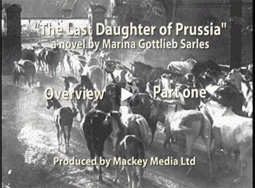 |
| A Roma gypsy couple at a German concentration camp during WW2 |
The Roma gypsies in East Prussia faced disaster during WW2. The idea to make Joshi Karas a Roma came as I was reading my grandfather’s book Schicksal OstPreussen – East Prussia’s Destiny. I learned that there were gypsies living on my family’s estate with whom my mother and my grandparents were very friendly. (See my earlier post - The Forgotten Holocaust.) One night, they disappeared. When my grandfather went to the police to inquire about them, he was warned that associating with ‘asocials’ was a crime punishable by death. Later, he discovered that his Roma friends had been shot or carted off to a concentration camp. I based Joshi’s story on this account. Many Roma were sent to Auschwitz, however, the closest death camp was Stutthof and as it was located near Danzig (the port city on the Baltic coast to which many refugees, including Manya, were headed) I used it as his ill-fated destination.
 |
| The Death Gate through which my hero Joshi passed when he arrived at Stutthof concentration camp. (Photo M. Gottlieb Sarles) |
 |
| Roma gypsies arriving at another concentration camp (Belzec) |
While the female warden, Elisabeth Martens is a fictional character, sexual exploitation of prisoners by both male and female wardens has been documented in accounts about concentration camps. It is estimated that 1.5 million Roma gypsies were murdered in Germany from 1935 to the end of the war. These gifted people, so unique in their ethnicity, were victims of yet another holocaust – a forgotten one. I wanted them to be remembered.
Lastly, in this chaotic arena of Nazis, marauding Russian soldiers and fleeing humanity were the Trakehner horses – East Prussia’s symbol of excellence and beauty, bred on the land for over two centuries. Loyal to the end, they struggled through that bitterest of winters without food or shelter to save their owners. My mother owned such a horse. I have attempted to reveal his bravery and big-heartedness in both Aztec’s and Shambhala’s characters.
 |
| My mother Owanta Gisela von Sanden in Guja, East Prussia on her Trakehner Dandy before the war. He was an amazing horse. She taught him to lie down while she was on his back. He did not make it to the west. Photo: (c) Gottlieb Property |
 |
| The stables where Dandy was kept before the war. Photo (c) Gottlieb Property |
The more I read about the Trakehners, the more I felt that they were the true heroes of the trek. Undeterred by race, creed or nationality, they hauled everyone across the ice including Russian and Polish prisoners-of-war and any remaining Jews or gypsies who had survived the Nazis. Obviously, the mass of refugees was German, but the horses weren’t interested in cultural differences, nor did they care about political beliefs. Surely, on that trek there were many Germans who sympathized with Hitler, but there were also many, like my grandparents, who did not. It didn’t matter to the horses. They focused on survival. Sadly, only 25 of the herd of 1200 warm-blooded thoroughbreds from the famous Trakehner Horse Farm in Trakehnen, made it safely to the west. The rest perished along the way, were eaten, stolen or shot in cold blood by Russian soldiers whose leader, Josef Stalin, had given orders to annihilate anything German, no matter how beautiful.
 |
| Fetysz Ox, the famous Trakehner stallion who was tragically shot by the invading Russian Army, but who nevertheless left his legacy as even Olympic competitors carry his valuable blood today. This horse greatly influenced my writing of The Last Daughter of Prussia. I could not imagine that anyone would kill such a beautiful animal and when I learned of his death, a plot about escape began to form in my head and I started writing and bringing in the characters, the land. the horses and the war. |
Thanks for reading. There is one more part of the prologue to come, so please stay posted!
– Marina Gottlieb Sarles
(c) All content and photos are the private property of the Gottlieb family, unless otherwise stated or linked, and may not be used without permission.
(c) Privatbesi




















